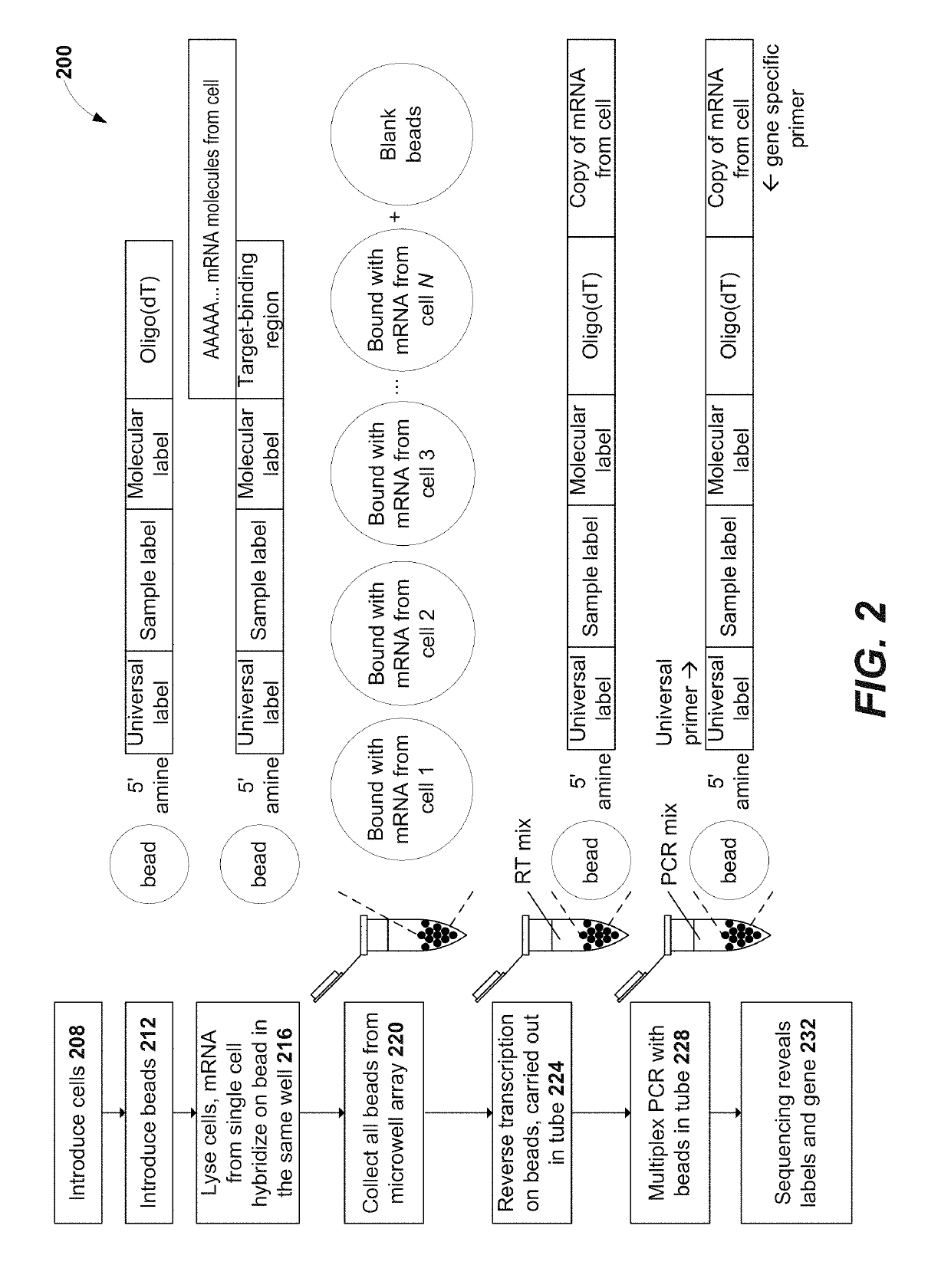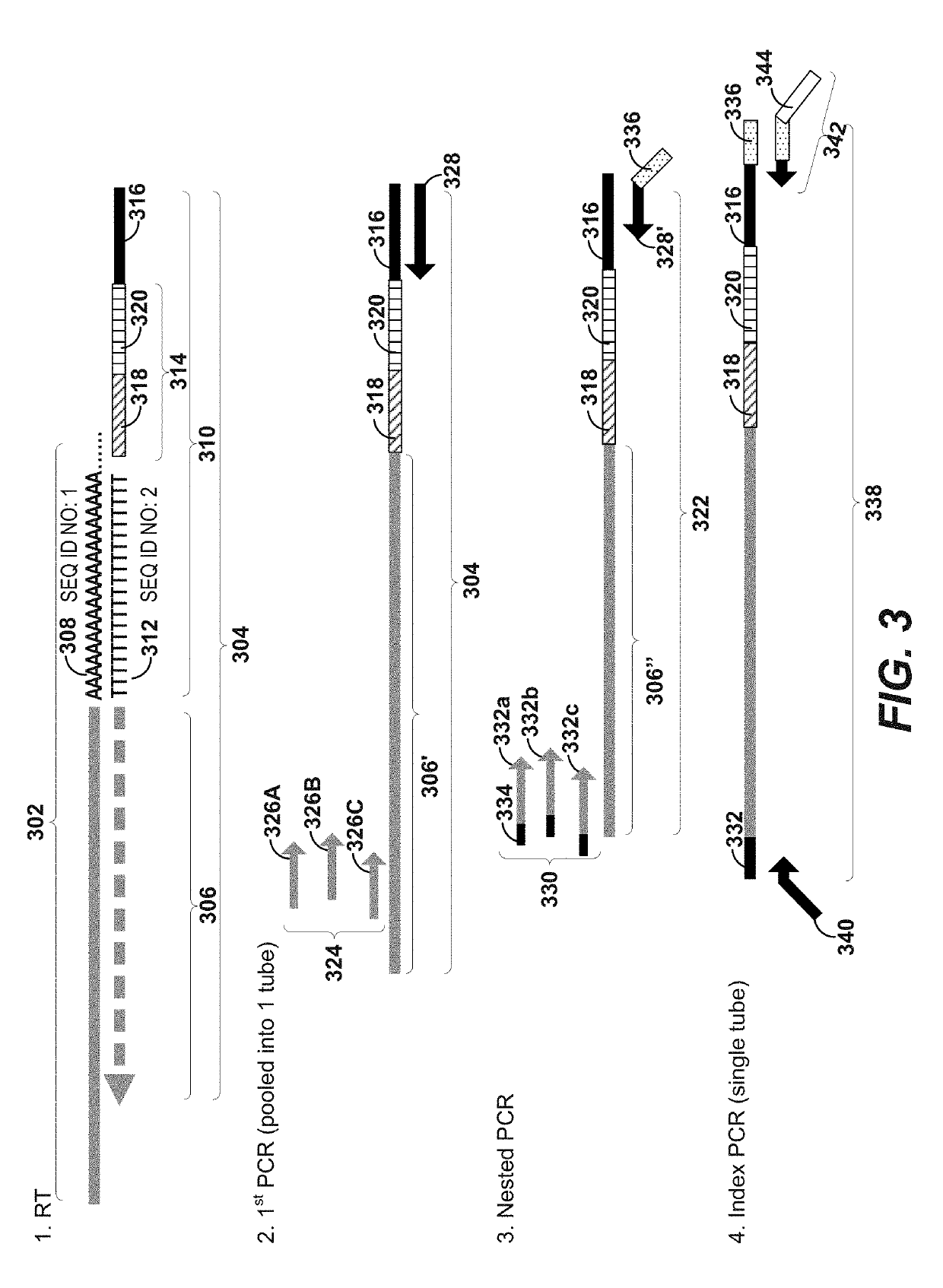Immune receptor-barcode error correction
a technology for immune receptors and barcodes, applied in the field of molecular barcoding, can solve problems such as overestimation of molecular counts
- Summary
- Abstract
- Description
- Claims
- Application Information
AI Technical Summary
Benefits of technology
Problems solved by technology
Method used
Image
Examples
example 1
ML Coverage of Each ML Across a Plate for a High Expresser Gene—ACTB
[0282]This example demonstrates distinct distributions of ML errors derived during sequencing or PCR generally have distinct distributions from true MLs.
[0283]In addition to absolute gene expression counting and PCR bias correction, MLs can provide a better understanding of the statistical quality of the library preparation procedure and sequencing data. When looking at the number of reads presenting the same gene ML—referred to as ML coverage—it is possible to detect for sequencing erroneous base calls or PCR errors generated during library preparation. For example, a gene ML from a given SL that is represented by multiple reads is likely an accurate measurement compared to a gene ML from a given SL that is represented by only a single read. Low ML coverage barcodes in the presence of high ML coverage barcodes in the same library are often artifacts or errors generated during the sequencing run or PCR steps during ...
example 2
Correcting Molecular Labels Due to PCR or Sequencing Substitution Errors
[0285]This example demonstrates a method for correcting molecular labels due to PCR and sequencing substitution errors that can be applied to whole transcriptome assays without the assumption of uniform coverage and without requiring high sequencing coverage for the complete sequencing status.
[0286]Deduplication was performed on the first mapping coordinate and unique molecular labels (UMI) of each read, and reads were assumed to be identical given the same start coordinate, UML, and strand. After deduplication, UMLs with the highest counts per cluster were retained (Table 13).
[0287]Molecular labels (MLs) were corrected on a per gene basis. For each gene, clusters of MLs were identified with directional adjacency. The directional adjacency method clustered MLs if the MLs were within a Hamming distance of 1 and a parent ML count≥2*(child MI count)−1. All MLs within the same cluster were considered to originate fr...
example 3
Molecular Label Counting for High Input Samples
[0289]This example describes unique molecular labels used as input molecules increase.
[0290]The BD Precise™ Targeted Assay may be the most suitable when used in small sample input—such as in single cells—to allow for stochastic and unique labeling of mRNAs. As the number of transcripts increases relative to the barcode pool in high RNA / cell input experiments, the percentage of MLs being recycled to label the same gene increases and was theoretically calculated using a Poisson distribution (FIG. 14). In these situations, without statistical correction, quantifying gene expression using MLs would underestimate the number of molecules that are initially present without any Poisson corrections or corrections based on two negative binomial distributions.
[0291]At extremely high input samples where the number of mRNAs per gene is beyond the entire collection of 6561 barcodes, a Poisson correction or a correction based on two negative binomial ...
PUM
| Property | Measurement | Unit |
|---|---|---|
| Distance | aaaaa | aaaaa |
| Distribution | aaaaa | aaaaa |
| Threshold limit | aaaaa | aaaaa |
Abstract
Description
Claims
Application Information
 Login to View More
Login to View More - R&D
- Intellectual Property
- Life Sciences
- Materials
- Tech Scout
- Unparalleled Data Quality
- Higher Quality Content
- 60% Fewer Hallucinations
Browse by: Latest US Patents, China's latest patents, Technical Efficacy Thesaurus, Application Domain, Technology Topic, Popular Technical Reports.
© 2025 PatSnap. All rights reserved.Legal|Privacy policy|Modern Slavery Act Transparency Statement|Sitemap|About US| Contact US: help@patsnap.com



